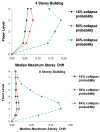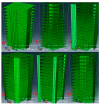Impact of Structural Stiffness on Vibration Periods of Concrete Buildings: A Systematic Review
- PMID: 40508609
- PMCID: PMC12156038
- DOI: 10.3390/ma18112612
Impact of Structural Stiffness on Vibration Periods of Concrete Buildings: A Systematic Review
Abstract
Research on the relationship between structural characteristics and vibration periods in concrete buildings is crucial to ensure the safety and efficiency of these structures, especially in earthquake-prone areas. This article aims to analyze and compare the impact of structural stiffness of different elements, such as beams, columns and shear walls, on vibration periods, through a systematic review of existing models and formulas in the literature, identifying their applications and limitations. The methodology used consists of a systematic review that integrates recent and relevant studies, providing a solid basis for analysis. The results indicate that an increase in the stiffness of structural elements can reduce vibration periods by 20-50%, implying a faster response to external forces. Even in low-rise buildings, the fundamental period can be reduced by 53% to 70%. These findings are significant for the design and construction of concrete buildings, as they suggest that incorporating rigid structural elements can improve seismic resistance and reduce the risk of damage. In addition, the research contributes to the field of structural dynamics by highlighting the need to integrate different methods of analysis and evaluation. It is recommended that engineers and architects adopt innovative approaches, such as the use of emerging technologies and monitoring methods, to improve damage detection and optimize structural design. Finally, it identifies areas where more research is required, suggesting that future studies should explore the interaction between structural characteristics and environmental conditions for a more complete understanding of the vibrational behavior of buildings.
Keywords: concrete buildings; dynamic response; stiffness; structural models; vibration periods.
Conflict of interest statement
The authors declare no conflicts of interest.
Figures






References
-
- Jamadin A., Kudus S.A., Ya’akob A.D.H., Misnan M.F., Jaini Z.M. Vibration-Based Finite Element Model Analysis on Dynamic Characteristics of Ultra-High Performance Concrete Beam. Int. J. Integr. Eng. 2023;15:213–223. doi: 10.30880/ijie.2023.15.07.020. - DOI
-
- Alrudaini T. Estimating vibration period of reinforced concrete moment resisting frame buildings. Res. Eng. Struct. Mater. 2023;9:1417–1432. doi: 10.17515/resm2023.724st0331. - DOI
-
- Regni M., Arezzo D., Carbonari S., Gara F., Zonta D. Effect of Environmental Conditions on the Modal Response of a 10-Story Reinforced Concrete Tower. Shock Vib. 2018;2018:9476146. doi: 10.1155/2018/9476146. - DOI
-
- Yanik Y., Aymelek A., Yildirim Ö., Demirtaş B., Türker T. Variations of natural frequencies of masonry minarets due to environmental effects. J. Civ. Struct. Health Monit. 2024;14:635–661. doi: 10.1007/s13349-023-00745-x. - DOI
-
- Sharhan Z.S., Cucuzza R., Domaneschi M., Ghodousian O., Rad M.M. Reinforcement of RC Two-Way Slabs with CFRP Laminates: Plastic Limit Method for Carbon Emissions and Deformation Control. Buildings. 2024;14:3873. doi: 10.3390/buildings14123873. - DOI
Publication types
Grants and funding
LinkOut - more resources
Full Text Sources

